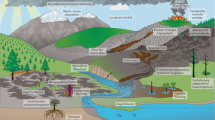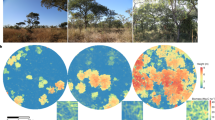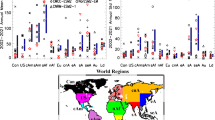Abstract
Adopting early dry season fires in African conservation areas has been proposed as ecologically desired and a means of generating sufficient carbon revenues for their management. We interrogate available peer-reviewed information on the ecology and biogeochemistry of fire in Africa to offer an informed perspective on the full implications of the proposal. We conclude that there is insufficient evidence that a shift to early dry season fires will reduce greenhouse gas emissions, that resultant biodiversity and ecosystem service outcomes may not be desired, and that adopting a single burning regime limits the use of fire to achieve a diverse range of goals.
This is a preview of subscription content, access via your institution
Access options
Access Nature and 54 other Nature Portfolio journals
Get Nature+, our best-value online-access subscription
27,99 € / 30 days
cancel any time
Subscribe to this journal
Receive 12 digital issues and online access to articles
118,99 € per year
only 9,92 € per issue
Buy this article
- Purchase on SpringerLink
- Instant access to full article PDF
Prices may be subject to local taxes which are calculated during checkout
Similar content being viewed by others
References
Tear, T. H. et al. Savanna fire management can generate enough carbon revenue to help restore Africa’s rangelands and fill protected area funding gaps. One Earth 4, 1776–1791 (2021).
Russell-Smith, J., Whitehead, P. & Cooke, P. Culture, Ecology and Economy of Fire Management in North Australian Savannas: Rekindling the Wurrk Tradition (CSIRO Publishing, 2009).
Russell-Smith, J. et al. Managing fire regimes in north Australian savannas: applying Aboriginal approaches to contemporary global problems. Front. Ecol. Environ. 11, e55–e63 (2013).
Lipsett-Moore, G. J., Wolff, N. H. & Game, E. T. Emissions mitigation opportunities for savanna countries from early dry season fire management. Nat. Commun. 9, 2247 (2018).
Edwards, A. et al. Transforming fire management in northern Australia through successful implementation of savanna burning emissions reductions projects. J. Environ. Manag. 290, 112568 (2021).
Laris, P. On the problems and promises of savanna fire regime change. Nat. Commun. 12, 4891 (2021).
Russell-Smith, J. et al. Opportunities and challenges for savanna burning emissions abatement in southern Africa. J. Environ. Manag. 288, 112414 (2021).
Pausas, J. G. & Bond, W. J. On the three major recycling pathways in terrestrial ecosystems. Trends Ecol. Evol. 35, 767–775 (2020).
IPCC 2019 Refinement to the 2006 IPCC Guidelines for National Greenhouse Gas Inventories Vol. 1 (eds Calvo Buendia, E. et al.) (IPCC, 2019).
Vernooij, R. et al. Dynamic savanna burning emission factors based on satellite data using a machine learning approach. Earth Syst. Dynam. 14, 1039–1064 (2023).
Andreae, M. O. & Merlet, P. Emission of trace gases and aerosols from biomass burning. Glob. Biogeochem. Cycles 15, 955–966 (2001).
Korontzi, S. Seasonal patterns in biomass burning emissions from southern African vegetation fires for the year 2000. Glob. Change Biol. 11, 1680–1700 (2005).
Chidumayo, E. N. Above-ground woody biomass structure and productivity in a Zambezian woodland. For. Ecol. Manag. 36, 33–46 (1990).
Ryan, C. M. & Williams, M. How does fire intensity and frequency affect miombo woodland tree populations and biomass? Ecol. Appl. 21, 48–60 (2011).
Archibald, S. Managing the human component of fire regimes: lessons from Africa. Phil. Trans. R. Soc. B 371, 20150346 (2016).
Smit, I. P. & Archibald, S. Herbivore culling influences spatio-temporal patterns of fire in a semiarid savanna. J. Appl. Ecol. 56, 711–721 (2019).
Wooster, M. J. et al. Field determination of biomass burning emission ratios and factors via open-path FTIR spectroscopy and fire radiative power assessment: headfire, backfire and residual smouldering combustion in African savannahs. Atmos. Chem. Phys. 11, 11591–11615 (2011).
Holdo, R. M. Stem mortality following fire in Kalahari sand vegetation: effects of frost, prior damage, and tree neighbourhoods. Plant Ecol. 180, 77–86 (2005).
Mlambo, D. & Mapaure, I. Post-fire resprouting of Colophospermum mopane saplings in a southern African savanna. J. Trop. Ecol. 22, 231–234 (2006).
Staver, A. C., Archibald, S. & Levin, S. A. The global extent and determinants of savanna and forest as alternative biome states. Science 334, 230–232 (2011).
Bastin, J.-F. et al. The global tree restoration potential. Science 365, 76–79 (2019).
Lupala, Z. J., Lusambo, L. P. & Ngaga, Y. M. Management, growth, and carbon storage in miombo woodlands of Tanzania. Int. J. For. Res. 2014, 629317 (2014).
Gomes, A. L. et al. Suffrutex grasslands in south-central Angola: belowground biomass, root structure, soil characteristics and vegetation dynamics of the ‘underground forests of Africa’. J. Trop. Ecol. 37, 136–146 (2021).
Handavu, F., Syampungani, S., Sileshi, G. W. & Chirwa, P. W. Aboveground and belowground tree biomass and carbon stocks in the miombo woodlands of the Copperbelt in Zambia. Carbon Manag. 12, 307–321 (2021).
Zhou, Y. et al. Limited increases in savanna carbon stocks over decades of fire suppression. Nature 603, 445–449 (2022).
Huang, Y. et al. A global synthesis of biochar’s sustainability in climate-smart agriculture—evidence from field and laboratory experiments. Renew. Sustain. Energy Rev. 172, 113042 (2023).
Findlay, N. et al. Long-term frequent fires do not decrease topsoil carbon and nitrogen in an Afromontane grassland. Afr. J. Range Forage Sci. 39, 44–55 (2022).
Awuah, J., Smith, S. W., Speed, J. D. & Graae, B. J. Can seasonal fire management reduce the risk of carbon loss from wildfires in a protected Guinea savanna? Ecosphere 13, e4283 (2022).
Manson, A. D., Jewitt, D. & Short, A. D. Effects of season and frequency of burning on soils and landscape functioning in a moist montane grassland. Afr. J. Range Forage Sci. 24, 9–18 (2007).
Fynn, R. W. S., Haynes, R. J. & O’Connor, T. G. Burning causes long-term changes in soil organic matter content of a South African grassland. Soil Biol. Biochem. 35, 677–687 (2003).
Coetsee, C., Bond, W. J. & February, E. C. Frequent fire affects soil nitrogen and carbon in an African savanna by changing woody cover. Oecologia 162, 1027–1034 (2010).
Jackson, R. B., Banner, J. L., Jobbágy, E. G., Pockman, W. T. & Wall, D. H. Ecosystem carbon loss with woody plant invasion of grasslands. Nature 418, 623–626 (2002).
Mureva, A., Ward, D., Pillay, T., Chivenge, P. & Cramer, M. Soil organic carbon increases in semi-arid regions while it decreases in humid regions due to woody-plant encroachment of grasslands in South Africa. Sci. Rep. 8, 15506 (2018).
Pellegrini, A. F. et al. Fire effects on the persistence of soil organic matter and long-term carbon storage. Nat. Geosci. 15, 5–13 (2022).
Hannerz, F. & Lotsch, A. Assessment of remotely sensed and statistical inventories of African agricultural fields. Int. J. Remote Sens. 29, 3787–3804 (2008).
Mapiye, C., Mwale, M., Chikumba, N. & Chimonyo, M. Fire as a rangeland management tool in the savannas of southern Africa: a review. Trop. Subtrop. Agroecosyst. 8, 115–124 (2008).
Mentis, M. T. & Tainton, N. M. in Ecological Effects of Fire in South African Ecosystems (eds Booysen, P. V. & Tainton, N. M.) 245–254 (Springer, 1984).
Scott, J. Pros and cons of eliminating veld burning. Proc. Annu. Congresses Grassl. Soc. South. Afr. 5, 23–26 (1970).
Koffi, K. F. et al. Effect of fire regime on the grass community of the humid savanna of Lamto, Ivory Coast. J. Trop. Ecol. 35, 1–7 (2019).
Trollope, W. S. W. Effect of season of burning on grass recovery in the false thornveld of the Eastern Cape. J. Grassl. Soc. South. Afr. 4, 74–77 (1987).
Strydom, T. et al. The effect of experimental fires on soil hydrology and nutrients in an African savanna. Geoderma 345, 114–122 (2019).
Chambers, B. Q. & Samways, M. J. Grasshopper response to a 40-year experimental burning and mowing regime, with recommendations for invertebrate conservation management. Biodivers. Conserv. 7, 985–1012 (1998).
Uys, C. & Hamer, M. The effect of long-term fire treatments on invertebrates: results from experimental plots at Cathedral Peak, South Africa. Afr. J. Range Forage Sci. 24, 1–7 (2007).
Smit, I. P. & Prins, H. H. Predicting the effects of woody encroachment on mammal communities, grazing biomass and fire frequency in African savannas. PLoS ONE 10, e0137857 (2015).
Hassan, S. N. & Rija, A. A. Fire history and management as determinant of patch selection by foraging herbivores in western Serengeti, Tanzania. Int. J. Biodivers. Sci. Ecosyst. Serv. Manag. 7, 122–133 (2011).
Donaldson, J. E. et al. Ecological engineering through fire–herbivory feedbacks drives the formation of savanna grazing lawns. J. Appl. Ecol. 55, 225–235 (2018).
Morris, C. & Fynn, R. The Ukulinga long-term grassland trials: reaping the fruits of meticulous, patient research. Bull. Grassl. Soc. South. Afr. 11, 7–22 (2001).
Morris, C. D., Everson, C. S., Everson, T. M. & Gordijn, P. J. Frequent burning maintained a stable grassland over four decades in the Drakensberg, South Africa. Afr. J. Range Forage Sci. 38, 39–52 (2021).
Tainton, N. M., Groves, R. H. & Nash, R. Time of mowing and burning veld: short term effects on production and tiller development. Proc. Annu. Congresses Grassl. Soc. South. Afr. 12, 59–64 (1977).
Meller, P., Frazão, R., Lages, F., Jürgens, N. & Finckh, M. Tipping the scales: how fire controls the balance among functional groups in Angolan grasslands. Afr. J. Range Forage Sci. 39, 56–69 (2022).
Louppe, D., N’klo, O. & Coulibaly, A. The effects of brush fires on vegetation: the Aubréville fire plots after 60 years. Commonw. For. Rev. 74, 288–292 (1995).
Trapnell, C. G. Ecological results of woodland and burning experiments in northern Rhodesia. J. Ecol. 47, 129–168 (1959).
Blaum, N., Seymour, C., Rossmanith, E., Schwager, M. & Jeltsch, F. Changes in arthropod diversity along a land use driven gradient of shrub cover in savanna rangelands: identification of suitable indicators. Biodivers. Conserv. 18, 1187–1199 (2009).
Sirami, C., Seymour, C., Midgley, G. & Barnard, P. The impact of shrub encroachment on savanna bird diversity from local to regional scale. Divers. Distrib. 15, 948–957 (2009).
Wieczorkowski, J. D. et al. Fire facilitates ground layer plant diversity in a Miombo ecosystem. Ann. Bot. 133, 743–756 (2024).
Beale, C. M. et al. Pyrodiversity interacts with rainfall to increase bird and mammal richness in African savannas. Ecol. Lett. 21, 557–567 (2018).
Turpie, J. Towards a Policy on Indigenous Bush Encroachment in South Africa (Department of Environmental Affairs, 2019).
van Wilgen, B. W., Strydom, T., Simms, C. & Smit, I. P. Research, monitoring, and reflection as a guide to the management of complex ecosystems: the case of fire in the Kruger National Park, South Africa. Conserv. Sci. Pract. 4, e12658 (2022).
Jeffery, K. J. et al. Fire management in a changing landscape: a case study from Lopé National Park, Gabon. Int. J. Protected Areas Conserv. 20, 39–52 (2014).
Van Wilgen, B. W., Govender, N. & MacFadyen, S. An assessment of the implementation and outcomes of recent changes to fire management in the Kruger National Park. Koedoe Afr. Protected Area Conserv. Sci. 50, 22–31 (2008).
Probert, J. R. et al. Anthropogenic modifications to fire regimes in the wider Serengeti–Mara ecosystem. Glob. Change Biol. 25, 3406–3423 (2019).
Humphrey, G. J., Gillson, L. & Ziervogel, G. How changing fire management policies affect fire seasonality and livelihoods. Ambio 50, 475–491 (2021).
Ribeiro, N. et al. The influence of fire frequency on the structure and botanical composition of savanna ecosystems. Ecol. Evol. 9, 8253–8264 (2019).
van Wilgen, B. W., Govender, N., Smit, I. P. & MacFadyen, S. The ongoing development of a pragmatic and adaptive fire management policy in a large African savanna protected area. J. Environ. Manag. 132, 358–368 (2014).
Laris, P. Burning the seasonal mosaic: preventative burning strategies in the wooded savanna of southern Mali. Hum. Ecol. 30, 155–186 (2002).
Laris, P., Dadashi, S., Jo, A. & Wechsler, S. Buffering the savanna: fire regimes and disequilibrium ecology in West Africa. Plant Ecol. 217, 583–596 (2016).
Clarke, H. et al. A flexible framework for cost-effective fire management. Glob. Environ. Change 82, 102722 (2023).
Pooley, S. A historical perspective on fire research in East and southern African grasslands and savannas. Afr. J. Range Forage Sci. 39, 1–15 (2022).
Bond, W. J. & Archibald, S. Confronting complexity: fire policy choices in South African savanna parks. Int. J. Wildland Fire 12, 381–389 (2003).
Laris, P., Jacobs, R., Koné, M., Dembélé, F. & Rodrigue, C. M. Determinants of fire intensity in working landscapes of an African savanna. Fire Ecol. 16, 27 (2020).
Alvarado, S. T., Silva, T. S. F. & Archibald, S. Management impacts on fire occurrence: a comparison of fire regimes of African and South American tropical savannas in different protected areas. J. Environ. Manag. 218, 79–87 (2018).
Schutz, A. E. N., Bond, W. J. & Cramer, M. D. Defoliation depletes the carbohydrate reserves of resprouting Acacia saplings in an African savanna. Plant Ecol. 212, 2047–2055 (2011).
Chidumayo, E. N. A re-assessment of effects of fire on miombo regeneration in the Zambian Copperbelt. J. Trop. Ecol. 4, 361–372 (1988).
Ward, D. S. et al. The changing radiative forcing of fires: global model estimates for past, present and future. Atmos. Chem. Phys. 12, 10857–10886 (2012).
Fisher, R., Vigilante, T., Yates, C. & Russell-Smith, J. Patterns of landscape fire and predicted vegetation response in the north Kimberley region of Western Australia. Int. J. Wildland Fire 12, 369 (2003).
Lawes, M. J. et al. Small mammals decline with increasing fire extent in northern Australia: evidence from long-term monitoring in Kakadu National Park. Int. J. Wildland Fire 24, 712 (2015).
Le Page, Y., Oom, D., Silva, J. M. N., Jönsson, P. & Pereira, J. M. C. Seasonality of vegetation fires as modified by human action: observing the deviation from eco‐climatic fire regimes. Glob. Ecol. Biogeogr. 19, 575–588 (2010).
Sawadogo, L., Tiveau, D. & Nygård, R. Influence of selective tree cutting, livestock and prescribed fire on herbaceous biomass in the savannah woodlands of Burkina Faso, West Africa. Agric. Ecosyst. Environ. 105, 335–345 (2005).
Trollope, W. S. W. Role of fire in preventing bush encroachment in the Eastern Cape. Proc. Annu. Congresses Grassl. Soc. South. Afr. 9, 67–72 (1974).
Parr, C. L. & Brockett, B. H. Patch-mosaic burning: a new paradigm for savanna fire management in protected areas? Koedoe 42, 177–130 (1999).
Acknowledgements
We acknowledge that N.S. receives funding from the Trapnell Fund (University of Oxford); S.A. from the OGRC Future Ecosystems for Africa Program; G.H. from UKRI Biotechnology and Biological Sciences Research Council Grant (number BB/V004484/1), USAID/NAS Partnerships for Enhanced Engagement in Research (Sub-Grant 2000004946, Cycle 3) and National Research Foundation South Africa (numbers 114974, 115998 and 118847); J.D. from USDA National Institute of Food and Agriculture Ecology and Evolution of Infectious Grant (number 2021-67015-33407); P.L. from the National Science Foundation (US) number 1313820; and G.J.H. from International Development Research Centre (IDRC), Ottawa, Canada. The views expressed herein do not necessarily represent those of IDRC or its Board of Governors. We thank C. Parry for editing the manuscript.
Author information
Authors and Affiliations
Contributions
T.K., N.S. and S.A. conceptualized the idea. T.K., N.S., E.E.A., M.A., C. Barbosa, C. Beale, W.B., E.C., C.C.-M., K.D., A.D., J.D., L.D., N.G., G.H., G.J.H., D.K., P.L., A.B.N., C.L.P., J.P., G.R., I.S., T.S., S.S. and S.A. contributed to the drafting and revision of the paper, and have approved the final draft thereof.
Corresponding authors
Ethics declarations
Competing interests
The authors declare no competing interests.
Peer review
Peer review information
Nature Sustainability thanks the anonymous reviewers for their contribution to the peer review of this work.
Additional information
Publisher’s note Springer Nature remains neutral with regard to jurisdictional claims in published maps and institutional affiliations.
Rights and permissions
Springer Nature or its licensor (e.g. a society or other partner) holds exclusive rights to this article under a publishing agreement with the author(s) or other rightsholder(s); author self-archiving of the accepted manuscript version of this article is solely governed by the terms of such publishing agreement and applicable law.
About this article
Cite this article
Knowles, T., Stevens, N., Amoako, E.E. et al. Viability and desirability of financing conservation in Africa through fire management. Nat Sustain 8, 226–233 (2025). https://doi.org/10.1038/s41893-024-01490-9
Received:
Accepted:
Published:
Issue Date:
DOI: https://doi.org/10.1038/s41893-024-01490-9
This article is cited by
-
Seven ways to prevent biomism
Ambio (2025)
-
Integrated fire management as an adaptation and mitigation strategy to altered fire regimes
Communications Earth & Environment (2025)



